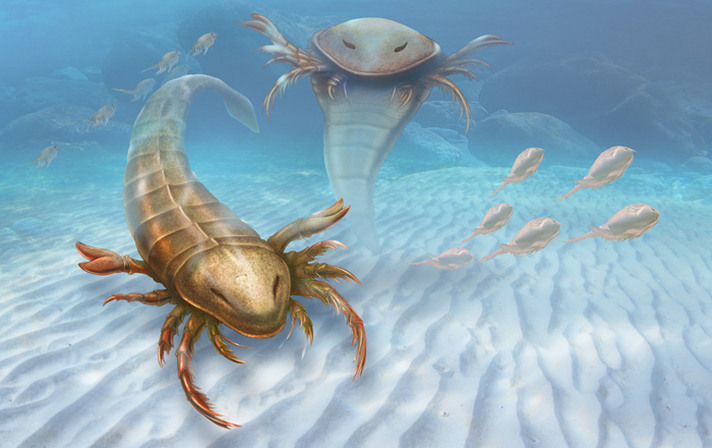What could a fossilized sea scorpion be doing in northeast Iowa? Well, it was likely swimming in the seawater that covered much of the central United States when a 5.6 km-wide meteorite struck the area nearly 470 million years ago.
Since 2007, IGS Researcher Paul (Huaibao) Liu has been leading a team to uncover the mysteries of the fossil fauna preserved in the

The exceptionally well-preserved adult and juvenile specimens that now reside in the IGS Rock Library give researchers insight into the development of the species, as well as its evolutionary history. Researchers now agree that eurypterids evolved 10 million years earlier than once thought. The discovery “opens a new window to tell us what Ordovician life was like,” adds Liu.
For the Pentecopterus, life was probably pretty easy. The six-foot-long invertebrate was equipped with long head shield, a narrow body, and large grasping limbs for trapping prey. No wonder it was named for an archaic Greek warship, the pentenconter. “Pentecopterus is large and predatory,” says James Lamsdell, a postdoctoral associate at Yale University and lead author of the study. “Eurypterids must have been important predators in these early Paleozoic ecosystems.”
Other species excavated from what is known as the Winneshiek Lagerstätte—a fossil bed situated beneath the Upper Iowa River—include conodonts, phyllocarids (shrimp-like animals), jawless fish, plant fossils, and others; researchers have even found species with imprints of soft tissue, which is very rare in the fossil record.
Liu, a paleontology expert, and his IGS colleagues were awarded a grant in 2010 to conduct research on the Winneshiek fossil fauna and the impact structure, diverting the Upper Iowa River just long enough to dig a pit and unearth the treasure trove of rock.
The findings were published in the Sept. 1, 2015, online edition of BMC Evolutionary Biology, along with detailed images of the fossils.
Liu, however, says the rest of the fossil fauna and the Decorah impact research is yet to be completed. Even now, with four articles submitted in 2015, his team isn’t finished. “We still have a lot of things to be done,” he notes.
The Iowa Geological Survey is part of IIHR—Hydroscience & Engineering, a research institute within the University of Iowa College of Engineering.